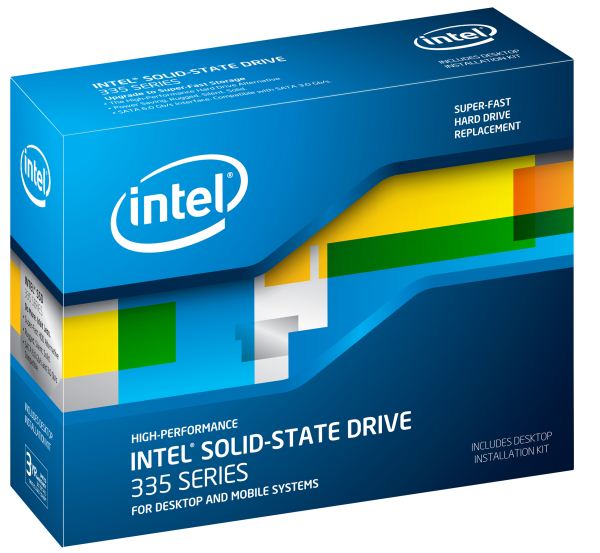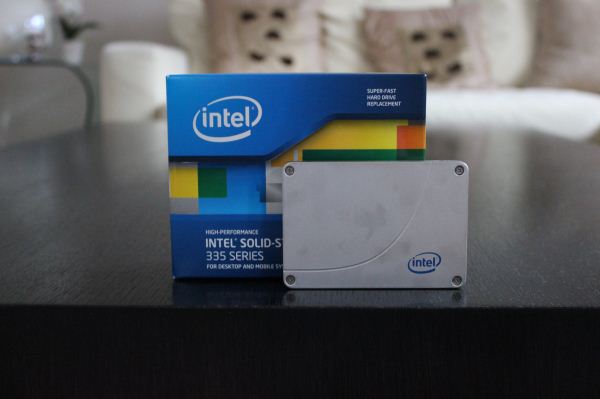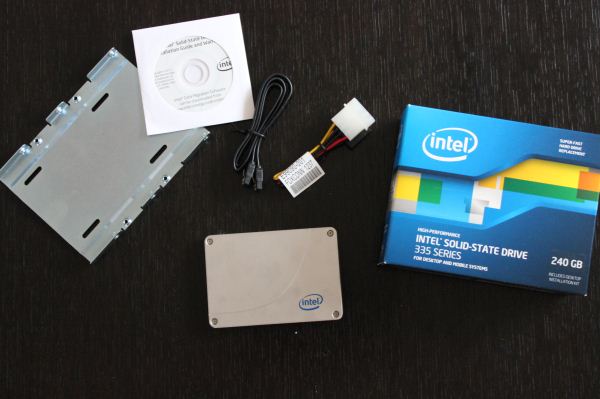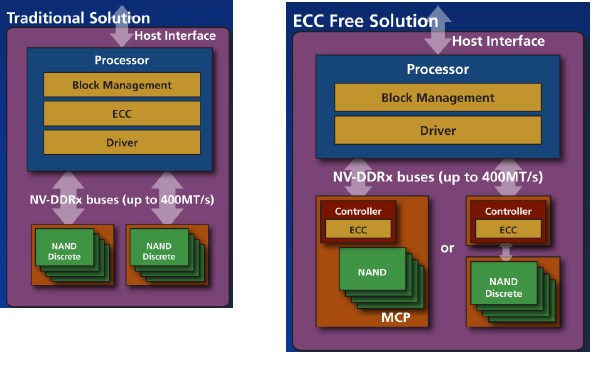Intel SSD 335 (240GB) Review
by Kristian Vättö on October 29, 2012 11:30 AM ESTIntroduction
Back in February, Intel released its first SandForce based SSD: the Intel SSD 520. Since then Intel's SSD lineup has evolved. A couple of months after the 520's release, Intel released a more mainstream focused SSD 330. Architecturally the SSD 520 and 330 were the same as both used SandForce's SF-2281 controller and IMFT's MLC NAND. The only real differences were limited to NAND quality and firmware; the 520 used higher binned NAND with more P/E cycles and its firmware was also more finely tuned to provide better performance.
While SandForce has yet to release its 3rd generation SSD controller, there's still room to upgrade one major component of these drives: the NAND itself. IMFT (Intel's and Micron's NAND joint-venture) has been fairly open about its next generation NAND products, including the transition to 20nm MLC NAND. Moving to smaller process geometries decreases die area, which increases the number of NAND die that can be produced on a single wafer (or increases the capacity that can reliably be produced on a single die). The move to 20nm is a necessary part of continuing to drive SSD costs down, although as with all process transitions we won't see those cost savings initially (die savings are offset by higher costs of a new process at the start).
IMFT's 20nm announcement happened back in April 2011. At the time, we were told not to expect to see 64Gb 20nm MLC NAND devices in SSDs until the middle of 2012. Now, a year and a half later, production is finally at a stage where volume and yields are both high enough for an actual product release. The vehicle for introduction? Intel's SSD 335.
As the name already suggests, the 335 is not a major upgrade over the 330. Intel usually reserves XX0 product names for bigger upgrades, such as the SSD 520 update where Intel moved to SandForce from a Marvell controller that was used in the SSD 510. The more minor updates (usually NAND die shrinks) only change the last number of the model. In other words, SSD 335 is essentially the SSD 330 but with 20nm MLC NAND instead of 25nm MLC NAND. Below is a full comparison of Intel's current consumer SSDs:
| Comparison of Intel's Consumer SSDs | |||
| SSD 330 (240GB) | SSD 335 (240GB) | SSD 520 (240GB) | |
| Capacities (GB) | 60, 120, 180, 240 | 240 | 60, 120, 180, 240, 480 |
| Controller | SandForce SF-2281 | ||
| NAND | Intel 25nm MLC | Intel 20nm MLC | Intel 25nm MLC |
| Sequential Read | 500MB/s | 500MB/s | 550MB/s |
| Sequential Write | 450MB/s | 450MB/s | 520MB/s |
| 4KB Random Read | 42K IOPS | 42K IOPS | 50K IOPS |
| 4KB Random Write | 52K IOPS | 52K IOPS | 80K IOPS |
| Warranty | 3 years | 3 years | 5 years |
At first, the SSD 335 will only be available in a 240GB capacity. I suspect that this has to do with 20nm NAND yields and volumes; it's a new process, yields are obviously lower and Intel hasn't had time to build an enormous stock yet. By only releasing a 240GB model at this point, which Intel tells us is the most popular capacity, it makes sure the 240GB model should be available in sufficient volume for the holiday market. If Intel had released all capacities simultaneously, it's possible that some capacities would have ran out of stock quickly. Intel likely still has a decent stock of 25nm NAND, so the 330 will stick around for at least a few months while the 335 ramps up additional capacities. The Intel SSD 520 will still be available as well, although I'm hearing that its successor is coming soon.
In terms of performance, the SSD 330 and SSD 335 are similar. This isn't shocking given that they are both based on the same controller and the only difference is the move from 25nm to 20nm MLC NAND. We aren't going to see any significant improvements in SandForce based SSDs until the third generation (SF-3000) controllers become available, which should be some time next year. There have of course been minor modifications to the firmware to support 20nm MLC NAND.
Similar to the SSD 330, the SSD 335 comes with a desktop installation kit including a 2.5" to 3.5" adapter, SATA cable and a Molex to SATA power adapter.
| NewEgg Price Comparison (10/29/2012) | ||||
| Capacity | 60/64GB | 120/128GB | 240/256GB | 480/512GB |
| Intel SSD 335 | N/A | N/A | $184 (MSRP) | N/A |
| Intel SSD 330 | $70 | $99 | $190 | N/A |
| Intel SSD 520 | $95 | $120 | $240 | $490 |
| Crucial m4 | $75 | $110 | $200 | $390 |
| Samsung SSD 830 | $100 | $85 | $170 | $530 |
| Samsung SSD 840 | N/A | $110 | $200 | $450 |
| Plextor M5S | $65 | $120 | $200 | N/A |
| OCZ Vertex 4 | $75 | $100 | $200 | $400 |
| Corsair Neutron | N/A | $130 | $220 | N/A |
Intel's target with the SSD 330 was to bring an affordable drive to the market and the SSD 335 continues this trend. Suggested retail price of $184 for a 240GB drive is very competitive and there aren't many drives that can beat that at the moment.
Update: The 240GB SSD 335 is already available in NewEgg for $210, which is unfortunately over $20 more than what the MSRP suggested.
The NAND
Intel's 20nm MLC NAND is mostly the same as its 25nm MLC NAND. We are still looking at 8GB per die with an 8KB page size, although Intel does have a 16GB die in development which will also increase the page size to 16KB. Since the key aspects are the same, there haven't been any dramatic changes to performance. Intel wouldn't provide us with any specific numbers but program latency is the same and erase time is slightly longer than its 25nm MLC NAND.
The new NAND also enables ONFI 2.3 support. ONFI 2.3 doesn't bring any bandwidth improvements as the spec still maxes out at 200MB/s. IMFT's 16GB die will feature ONFI 3.0 support, bringing the maximum bandwidth between the controller and NAND to 400MB/s per channel. The biggest new feature in ONFI 2.3 is support for the EZ-NAND protocol, although Intel has not adopted this protocol to its NAND. EZ-NAND allows ECC to be offloaded from the SSD controller to a separate controller (can be integrated into the NAND package as well):
Normal NAND on the left - EZ-NAND on the right
The advantage of offloading the ECC from the controller is that now ECC can be updated along with NAND without the need for a new controller. ECC is strictly implemented in hardware, which means a firmware update doesn't help; you will need a new physical controller to update ECC. As we move to smaller process nodes, the need for ECC increases as the error rate goes up. With more error prone NAND, it becomes even more important to decouple ECC generations from the host controller since the same controller can be used for more than one NAND generation. In the Intel SSD 335, ECC is still handled by the SF-2281 controller but in theory, manufacturers using Intel NAND could implement a third party off-chip ECC controller in their SSDs.














69 Comments
View All Comments
meloz - Tuesday, October 30, 2012 - link
>After Anandtech's 840 Pro review sample died, I'm not super inspired with confidence about the plain 840.Oops, I had almost forgotten about that, thanks for the reminder.
Damn, all SSD manufacturers suck in their own ways.
jwilliams4200 - Thursday, November 1, 2012 - link
I'm disappointed that there hasn't been any more information on that 840 Pro that died.Anand should really post some more details. Like what it was doing just before it died, the symptoms of how it failed, whether the SMART parameters could still be read, etc.
Also, Anand should be hounding Samsung to get back to him about it, if they haven't already. The 840 Pro is apparently shipping on Nov 6. If Samsung has not been able to diagnose the problem and report back by then, it looks bad for Samsung.
Kristian Vättö - Thursday, November 1, 2012 - link
Anand was filling the drive with sequential data (preconditioning it for our enterprise tests) and it just died in the middle of the run. After that it was no longer recognized in BIOS, not even when connected using USB to SATA adapter.As far as I know, Samsung has not gotten back to us about it yet but let me ask Anand and see if he knows more.
jwilliams4200 - Thursday, November 1, 2012 - link
Thank you for the additional information.I am highly interested in what Samsung has to say about the failure. It seems to me that anandtech should be able to put some pressure on Samsung to give them a thorough failure analysis in a timely manner, or else anandtech will report that Samsung was unable to explain the failure and that looks bad for Samsung.
mmonnin03 - Tuesday, October 30, 2012 - link
The flash on SSDs arent going to get more reliable. ECC basically scales exponentially as the process dimensions keep shrinking. As the lines get closer and closer, the number of electrons holding the charge becomes harder and harder to measure. Each cell is 2 bits, so 4 different amounts of electrons need to be measured. Errors occur more frequently and get fixed. And that's not going to make the NAND any faster by going smaller. SSD speed/reliability improvements will/have come at the controller level. If you truly want a reliable SSD, go 34nm SLC. Its still being produced.jeffrey - Monday, October 29, 2012 - link
Between the Samsung 840 Pro dying during testing and now the endurance issue testing Intel's 335, I believe OCZ should get some more credit for their Vertex 4.Everyone wants to mention Intel, Micron/Crucial, and Samsung for SSDs, but the Vertex 4 deserves to be there too.
josephjpeters - Monday, October 29, 2012 - link
Endurance will play a larger role in differentiating future SSD's as the industry continues to move to smaller NAND geometries.I'm interested in seeing OCZ's Vector which will use 20nm MLC NAND. It'll be a big test for OCZ to see how their endurance technology stacks up against the competition (or lack thereof in the consumer space).
Samus - Monday, October 29, 2012 - link
I've had my Intel SSD320 160GB for about two years, use it daily, and still have only written 10.6TB to it and the MWI is still 100%.Either way you look at it, this drive will last the average user a decade easily, even with less than 1000 P/E
IntelUser2000 - Tuesday, October 30, 2012 - link
This is false: "Based on the data I gathered, the MWI would hit 0 after around 250TB of NAND writes, which translates to less than 1,000 P/E cycles."There is a forum that exclusively tests SSD endurance and Intel drives last far past the MWI of 0. In fact, after it reached zero, it started counting up. I remember the original X25-M lasting until the second MWI is significantly greater than 25(it could be 50 I don't remember).
They thought that after the Media Wearout Indicator reached 0, the drive would die. In fact, none of the drives did. NONE.
Even 240TB is hell of a lot. My X25-M has 7.6TB written to it and I had it since the year the drive was announced. At this rate, I'll be 30 years older by the time it reaches that point. So its a needless worry about nothing.
Contrary to Platter HDDs, which die off slowly and more and more data gets corrupted and gets slower and slower until you notice that the drive is dying. Less than 5 years for lot of people around me too.
Kristian Vättö - Tuesday, October 30, 2012 - link
I did not say the drive will die after the MWI hits 1. In fact, I said the opposite:"Even after it has hit 1, it's likely the drive can still withstand additional write/erase cycles thanks to MLC NAND typically behaving better than the worst-case estimates."
The problem here isn't that 1,000 P/E cycles isn't enough for a consumer, but the fact that there seems to be a huge difference in endurance between 20nm MLC and 25nm MLC if our data is correct. Intel claimed that there is no difference, both are 3,000 P/E cycles, but our data contradicts with theirs. Given that the SSD 335 doesn't bring any immediate price cuts, you are getting a worse product for the same money compared to the SSD 330.
It's of course possible that there is a simple firmware bug which reports wrong MWI or NAND writes, but at least so far Intel has not said anything to suggest that.